When suddenly faced with a cockroach, your first instinct may be to step on it. However, some people are hesitant due to urban myths. For example, you may think that squashing a roach will release its eggs, allowing more to hatch. Others claim that a crushed roach will give off pheromones that attract other cockroaches, but they are baseless myths.
If you squish a cockroach, it will die. Roaches do release a pheromone upon death, but it’s a warning, not an invitation. Roaches will avoid other dead roaches unless they’re starving. Stepping on roaches won’t release eggs. Very few species carry their eggs with them, and if one does, the eggs will get crushed along with their mother.
With that said, squishing a roach takes impressive force. Cockroaches have hard exoskeletons that protect them from getting bashed around. They will survive being stepped on if you don’t mean it. Be sure to inspect the body for the right amount of lethal damage. Listen out for a popping sound to indicate that its exoskeleton has cracked.
Do Cockroaches Die When You Step On Them?
Roaches can die when you step on them. However, for the average person, you’ll find this is trial and error. Many people rarely use the correct amount of force to crush a roach.
To do it properly, you shouldn’t just step on a roach with the intent to kill it. You should intend to squish it out of existence. If that seems like overkill, you should consider how much force a roach can withstand.
Why Didn’t My Shoe Crush A Roach?
As invertebrates, their organs and muscles are completely shielded by hardened exterior skin. This is called an exoskeleton or shell. The main component in exoskeletons is chitin. That’s comparable to keratin, which makes up horns, claws, and hooves in other animals.
Exoskeletons provide insects with a proper frame for their muscles. Without it, their segmented bodies would fall apart. That’s why rigidness is key when it comes to exoskeletons. Even their apodemes (ingrowths that aid with the muscles’ attachment) are twice as stiff as the tendons of a vertebrate.
Knowing all of this, it’s no wonder cockroaches are difficult to kill even when getting stepped on. They can handle 300 to 900 times their own body weight. Worse yet, they can squeeze through 4-millimeter crevices because of their astounding flexibility.
Depending on the sole of your foot, the cockroach can easily contort around the tread. It may come out of the ordeal relatively uninjured.
Does Squashing a Cockroach Kill It?
However, that doesn’t mean that squishing a roach doesn’t work. This can kill it if done right. In fact, squashing can be the most effective way to ensure a roach’s death.
These insects can play dead at a masterclass level. Just because they’re holding still doesn’t mean they’re dead. Likewise, their regeneration abilities mean they can walk away from devastating injuries.
But what can’t a roach regenerate from? A fully crushed body. If the roach is flattened out and pulverized, it cannot recover from this amount of damage. You can dispose of it how you please. You’ll know a roach is properly squashed if you hear a popping sound.
Why Do Cockroaches Pop When You Step On Them?
Roaches pop when their exoskeleton cracks. After all, the material that it’s composed of is thick and hardy. If damaged enough to break, it’s similar to snapping plastic.
With a cracked exoskeleton, the cockroach will no longer be able to control its muscles. Even if it’s not killed on the spot, it will not be capable of movement afterward. That means it will starve to death if left alone.
A cracked exoskeleton also exposes its organs to damage. The shell itself may crumble inwards and pierce its soft guts. Without the shell structure to encase the organs, the force of your foot will proceed downwards. This can and will smash the roach’s insides, which should cause immediate death. You should be able to confirm this visually.
What Does a Squashed Cockroach Look Like?
A properly-squashed roach will be surrounded by evidence of its death. This includes:
- Pieces of the cracked exoskeleton
- Droppings
- Crushed organs
- Dismembered limbs or antenna
It will also secrete a white substance. Many people confuse this for milk, but it’s actually blood. Cockroach blood is white due to a lack of hemoglobin. That’s a red protein in charge of carrying oxygen through a vertebrate’s body.
As mentioned, roaches are good at playing dead. Don’t let them fool you. A cockroach that is not properly squashed will not die; it will only be stunned into defecating.
Cockroach droppings look like small brown specks. It may seem like coffee grounds are surrounding the roach, but nothing else. In this case, you can’t trust its injuries will finish the job. You’ll need to brace yourself and smash it again.
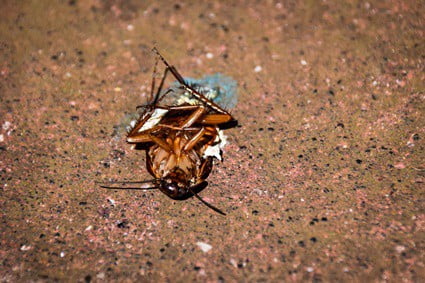
What Happens If I Only Squash Half a Cockroach?
The last moments of a half-squashed cockroach vary greatly. It will depend on which half was squashed. To us, it may seem like the uncrushed half of the roach is just flailing around. However, for the cockroach itself, the sensations can range from extreme confusion to nothing at all.
That’s because cockroaches have two brains. One is in their head, and the other is in their posterior. The brain located in the head is in charge of:
- Limb regeneration
- Senses
- Memory
- Hormone secretion
- Suppress reproductive behavior
The second brain located in the back is considered to be a more primitive brain and is in charge of:
- Sexual activity
- Maternal instincts
- Triggering apparent death behavior
- Sensory information
What If I Crush The Head Of A Roach?
When scientists cut off a cockroach’s head, they found that limb regeneration was no longer possible. It didn’t matter that the roach was technically still alive.
If a cockroach’s head is squished, it will stay alive for 10 to 20 days. As long as the temperature is kept at 75.2 degrees Fahrenheit and the humidity is 80 percent, it only dies through starvation. Cockroaches have ganglia dispersed throughout every segment of their bodies. As such, their limbs will still be responsive despite the crushed head.
Even without a head, the second brain can still perform primitive functions without the primary brain’s direction. When ready to copulate, male roaches will twist their bodies into an S-curve. Usually, it’s the head brain that regulates this behavior through hormones. However, when researchers ligated the head of multiple male roaches, they could still halfway twist their bodies into the S-curve.
This posited a compelling theory: When cockroaches lack a head brain, their second brain takes over.
What If I Crush The Butt Of A Roach?
Researchers found that the memory of a cockroach is affected when their second brain is missing. Despite their memory, cockroaches require their second brain to learn and retain any information. That’s because they rely on their lower body to send sensory cues to the head.
The first brain cannot function properly without that second brain. As such, a cockroach with a crushed lower body will struggle to find its way back home or look for shelter.
Without the second brain, the cockroach will not receive enough sensory information to know what objects are in the way. It will fumble around aimlessly or attempt to, depending on how many legs it has left. Eventually, it will starve to death or be eaten by predators.
If You Step On A Cockroach, Does It Release Its Eggs?
A popular myth says that cockroaches will eject their eggs upon being crushed. This can leave you terrified to smash one. After all, it gives you only two choices:
- Step on it and risk spawning more roaches.
- Let the pest out of your sight as you get insecticide, tissues, or a jar.
The good news is that this is false. Cockroaches do not release their eggs when they’re stepped on. That’s for two obvious reasons:
Most Roaches Don’t Carry Their Eggs
Most female cockroaches carry their eggs in an ootheca. An ootheca is an elongated egg mass containing as many as 30 to 40 cockroach eggs. However, some species produce less than that.
According to the Department of Zoology at Oxford University, ootheca are hardened structures made up of the same protein as a cockroach’s exoskeleton. As such, the protected case is incredibly resilient. It’s usually shaped like a pill, brown or black, and has a leathery texture.
Most cockroach species find multiple small, damp crevices to lay their eggs in. They will hatch weeks later. Since they do not carry their ootheca with them, you can step on the roaches worry-free. You will not spread the eggs around.
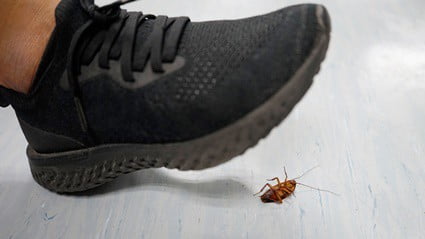
Stepping On A Roach Kills The Eggs
With that said, a few species carry their eggs at the end of their abdomens. Even rarer, some species carry eggs inside their bodies. These have a live birth.
If you happen to step on a cockroach of this variety, don’t worry. The eggs will be crushed underneath the weight of your foot. The babies will not survive. The egg cases may be tough enough to protect the unborn roaches from bacteria and weather. However, it can’t protect them from getting stomped on by a human.
What if a couple of eggs do survive? In this improbable scenario, they would be born in an exposed environment. They would have trouble completing their molting cycle and reaching adulthood. Without the comfort of their small holes, they would likely die in short order.
There is also a chance that the ootheca attached to a female roach is actually empty. Ootheca have a small ridge running along its side. This is where the cockroaches break through when they are ready to hatch. Once the nymphs are out, the ridge closes itself back up again.
It can sometimes take a few hours for the ootheca to detach itself from the mother roach. So, after stepping on a cockroach and seeing what might look like an ootheca, don’t panic. It could be empty.
Does Killing a Cockroach Attract More?
Cockroaches do release a pheromone when they die. This smell will alert other roaches in the area and send a message. However, contrary to popular belief, this isn’t a signal to invade. It’s a warning that says, “there’s danger, so run away.”
When cockroaches find a good spot to turn into a nest, they release a series of pheromones. That signals to other cockroaches that a new home can be made there. On the flip side, when cockroaches die, they also release a smell that lets other insects know where the death occurred.
According to biologist David Rollo of McMaster University, cockroaches release fatty acids (oleic acids, specifically) when they die. His team attempted to extract the cockroach-attracting pheromone but had difficulty doing so on live roaches. Instead, they crushed cockroach parts and spread them around potential nests. Here, they found that cockroaches would avoid those places at all costs.
Through a series of experiments, his team discovered that cockroaches could warn each other. They keep away from places where other roaches die because the smell produced by fatty acids indicates danger.
Does A Dead Roach Attract Hungry Roaches?
The corpse of a dead roach may be an appealing meal to others of its kind. However, it’s not immediately an attractant. Cockroaches do engage in cannibalistic behavior, but only when they have no other choice.
Cockroaches will always prefer eating something other than their own if they can help it. If you see one eating a roach corpse, it definitely means it’s starving. Usually, cockroaches can be seen eating their own in clean houses where they have trouble finding food.
As such, you can step on cockroaches worry-free. As long as you apply the right amount of force, they will die without consequences.
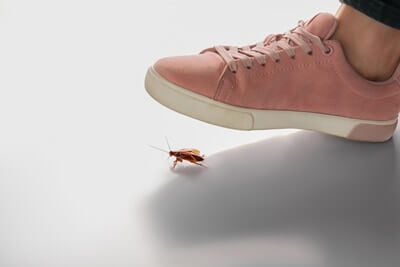
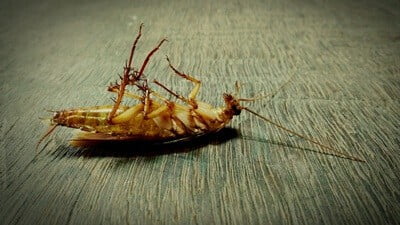
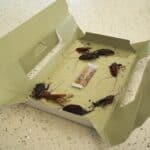
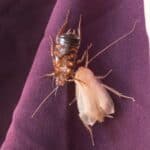
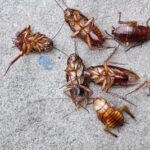
I always wondered when I squashed a roach with my foot what was the white stuff and why did it make a popping when I would step on it..I also found that just stomping on them might not kill them right away, however if you can catch them under your foot , you use the weight of your foot to press down, and squish or as your mentioned feel it pop …even if they’re on thier backs obviously it makes easier to squash them use the same technique.
Best shoe I use for this is my ladies Keds Oxford type tennis shoe…these shoes don’t have any types of grooves in the sole of the shoe.. they just have a bare rubber sole on them so I don’t have to worry about it or it’s guts sticking to the bottom of my shoe.